| ARTEMIS Text and research by Manuela Caregnato for www.ilcerchiodellaluna.it Translation by Katiuscia Cancedda translatethis1@yahoo.co.uk |
Versione italiana |
Hymn to Artemis
|
Wild Goddess You who are virgin You that at the edge You grant to exchanges You who are the ruler |
||
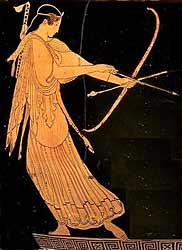 |
The merciless Moira And an invincible Father And a shining Brother Perhaps condemned you to the sacrifice of love unions, of matrimony and the joy of childbirth But you elate yourself With the wounded prey’s cry And with the maidens’ chants Who sacrifice Innumerable The virgin flower To your face. |
Of you We won’t forget The name that helps Should we find Ourselves lost In nameless grounds And your arrow Reliable Pierce our heart When the time has come And do not abandon us To the anguish Of a long agony* |
ARTEMIS GODDESS
Research by Martina
Birth of Artemis and her role in the Olympus Artemis.
Artemis, Goddess of hunting and of the New Moon, is Zeus’ daughter (God of Heaven) and Leto (Nymph) and twin sister to Apollo (God of the Sun).
Artemis, born in the island of Delos before Apollo, helped her mother to give birth to her brother.
One day, while she was still a 3 year-old girl, her father Zeus sat her on his lap and asked her what gifts she would have liked.
She replied: “Eternal virginity, eternal youth, as many names as my brother Apollo has, a bow and some arrows like his, the duty to bring light, a saffron coloured hunting tunic with a red edge that comes up to my knees, sixty young Oceanian Nymphs of the same age as my bridesmaids, twenty river Nymphs to look after my shoes and my dogs while I’m busy hunting”. Artemis reached out to stroke Zeus’ beard who smiled proudly. She thanked him, jumped off his lap and then chose several 9 years-old Nymphs as her maids.
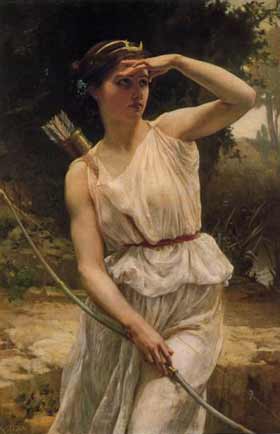 |
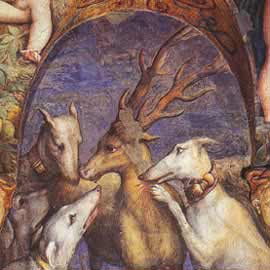 |
The Goddess Artemis is one of the twelve great divinities of the Mont Olympus together with her brother Apollo. The Romans identified her as Diana.
She is often confused with three other divinities that are actually different: Selene (Goddess of the Full Moon), Hekate (Goddess of the Waning Moon) and Siria (Goddess of Metamorphosis).
Artemis’ sacred name
The Goddess had different epithets: Agrotera, Cynthia, Hekate, Phoebe, Cordaca, Orthosia, Orthia, Ortigia, Stymfalia, Coritalia, Caryatides, Daphnia, Delia, Brauronia, Elaphebolos, Tauropolos, Apanchomene, Eileithyia, Anahita, Leucophrine.
Artemis’ character and her deeds
Artemis is the archer goddess living with the woods’ nymphs, symbol of freedom, of sisterhood and of the ability to hit one’s own targets.
Goddess of wild animals, Artemis used to be hailed by women to alleviate the pains of childbirth. However, sometimes she has a wild and vindictive character and many were the victims of her rage:
1) One of her first ventures was to kill Niobe’s children with her brother Apollo, task given to her by her mother Leto. In fact, one day Leto overheard Niobe saying that she was a superior heroine and, offended by such affirmation, she asked Apollo to kill her sons and to Artemis to kill her daughters.
2) Orion tried to rape Artemis and the Goddess, wrathful, sent a scorpion against him, which stung Orion’s heel killing him. For its service, the Goddess transformed the scorpion and its victim, Orion, into constellations, and this is why the constellation of Orion always flees Scorpio’s.
3) Actaeon had inadvertently noticed Artemis while she bathed naked at a spring. Raged, the Goddess stirred the pack of his own fifty dogs against him, whom she had meanwhile turned into a deer; the dogs did not recognise their owner in his new appearance and savaged him.
Artemis’ attributes
Dressed in a short tunic, armed with a silver bow and a quiver full of arrows on her shoulder, Artemis would wander through the woods with a bevy of nymphs and her dogs. She was associated to several wild animals, symbols of her qualities: the deer, the hind, the hare and the quail for their receding nature; the lioness for her regality and the fierce bear for her destructive aspect. The bear was also the deserved symbol of her role as protector of the young. She was also associated to the wild horse for her freedom. She is represented with a torch in her hand and her head surrounded by the moon and stars, as Goddess of the Moon.
ARTEMIS, SISTERHOOD AND NATURE
By Manuela Caregnato


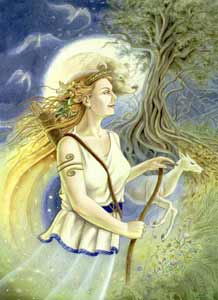
As Goddess of hunting and of the Moon, Artemis is the personification of the independent feminine spirit. She is part of the category of virgin goddesses and, unlike others, she was never kidnapped or abused of, and represents a sense of integrity, of awareness, whose worth does not depend on with whom she is, but on what she is and can do. Her ability as archer makes her the archetype of a feminine with a target hit without delay, therefore representing the ability to fulfil one’s own projects, once focussed on them.
Although she is competitive, Artemis never sees other women as rivals, but rather as sisters. In fact, she runs along wild places always accompanied by her nymphs, minor divinities from woodlands, mountains and streams. Moreover, she becomes very angry and takes action to defend other women when these are in danger. It is thus a feminine with a sense of solidarity for other women, whose company she considers indispensable and whose rights she mighty defends. For this reason she represents a symbol for many feminist movements.
She has a comradely behaviour with men, and she certainly doesn’t fall prey of devotion and attraction. Her twin brother Apollo, God of the Sun, can be seen as her masculine counterpart: he’s the sun, she’s the moon.
Her love for wild life, for unspoilt places and wild animals also makes her an ecologist woman model, bound in the fight for the conservation of the environment.
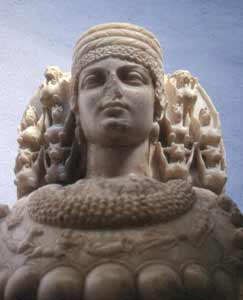 |
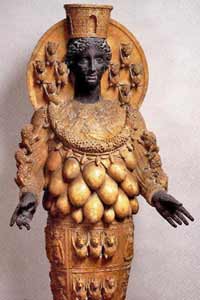 |
The archetype Artemis does not coincide with a type of woman that finds realisation in maternity, but represents a free and self-sufficient type of feminine that finds satisfaction in being her self fully, in fighting for what she believes in and in touch with nature, which represents our utmost wild side.
However, having helped her mother give birth to her brother, she's considered the Goddess of delivery and protector of parturient, who call upon her at the time of need. She's in fact represented as Goddess of the hundred breasts, as can be seen in this representation of Ephesian Artemis.
RELATIONSHIP BETWEEN ARTEMIS’ MANIFOLD
By Patricia Monaghan**
As Western art depicts her, Artemis is the virgin lunar goddess that wanders around woodlands and forests accompanied by her cortege of nymphs, armed with arch and quiver, avoiding men and killing any who dares gazing at her. However, this familiar version is only but one of many identities of this complex Greek Goddess: in fact, she was even the many breasts Artemis of Ephesus, a semi-human symbol of fecundity and the warrior Artemis, considered the protector of Amazons. It is difficult to understand if Artemis was originally an omni-comprehensive goddess later divided into two distinguished identities, or if she had rather acquired such a complex nature by absorbing attributes previously marking minor goddesses, so that her followers could obtain the ruling of Greece.
In any case, Artemis, as much as Isis or Ishtar, turned out to represent the changing feminine energies, which is where her inconsistency starts: she was the virgin practising sexual promiscuity; she was the hunter protecting the animals; she was a tree, a female bear, the moon. Artemis was the image of the woman who, through her life, gradually takes different roles, a real compendium of feminine potentials.
 |
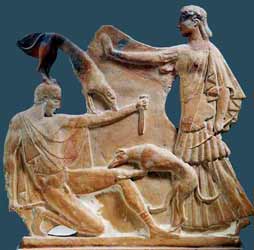 |
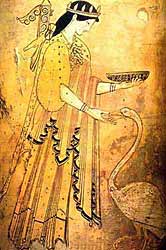 |
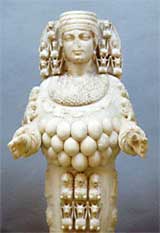 |
In one aspect, Artemis was a nymph ruling on all her nymphs, an elementary force whose kingdom were woods, in which an order far different from the humans’ was in force, which would appear to the humans as formless and free; this freedom, though, is the one of total obedience to the instinct still owned by animals, as opposed to that of humans.
Artemis was considered the Lady of hunting under this aspect, the power of the instinct that secures the survival of the species through the killing of others. As Lady of the animals, she was considered by the Greek the invisible guardian of wild animals, she who killed with her spiky arrows anyone hunting down pregnant beasts or cubs.
Another instinct on which she watched over was reproduction in its manifestations of sex and childbirth: she kept her role of protector of parturient, even on later legends; when her importance as goddess was shadowed by that of gods, the myth still described Artemis as the twin of the sun (born before him, whom originally wasn’t considered her brother), who would have acted as midwife during his birth. Artemis was the force of creation, she who Greek mothers would call upon when labour started, finding solace in the belief that she would assist them during labour just as she would do for any female animal that was about to give birth.
After all, the aspect of woodland nymph does not differ much from the more popular of Mother Artemis, whose great temple in the city of Ephesus was connected to the memory of the Amazons, and was one of the ancient world’s wonders. Her massive statue was erected there, characterised by a limbless powerful bust from which a considerable number of breasts hanged, with her head girded by the turreted crown of the city. This Artemis was only a different visualisation of the same energy represented by the woodland’s nymph: the vital instinct, leading to continually produce and reproduce, to devour and die. In the image of the Ephesian Artemis there’s a force that could be perceived as much terrifying as it appears enormous and inhuman.
As Greece’s most venerated Goddess, Artemis was honoured with common rituals, as much varied as the many aspects of the Goddess herself. Artemis was served in her rich temple in Ephesus by chaste priestesses, name Melissae, or bees, and by eunuch priests. She was Korythalia in Sparta, honoured with orgiastic dances. The Amazons venerated Astatheia, the mother of war, with a circular dance during which they stroke their shields and stamped the ground wearing combat boots. It appears, though, that the most popular festivals in Her honour were those celebrated on full moon nights, during which the faithful gathered in the woods sacred to the Goddess and surrendered to Her powers, revelling and mating without knowing each other. The most favourite Greek goddess was therefore the personification of the natural laws, so different from those of society, as much ancient and perhaps intended to last eternally.
_________________________________________________________________________________________
Hymn to Artemis
Birth of Artemis and her role in the Olympus Artemis.
The Goddess Artemis is one of the twelve great divinities of the Mont Olympus together with her brother Apollo. The Romans identified her as Diana.
ARTEMIS, SISTERHOOD AND NATURE
The archetype Artemis does not coincide with a type of woman that finds realisation in maternity, but represents a free and self-sufficient type of feminine that finds satisfaction in being her self fully, in fighting for what she believes in and in touch with nature, which represents our utmost wild side. However, having helped her mother give birth to her brother, she's considered the Goddess of delivery and protector of parturient, who call upon her at the time of need. She's in fact represented as Goddess of the hundred breasts, as can be seen in this representation of Ephesian Artemis.
RELATIONSHIP BETWEEN ARTEMIS’ MANIFOLD As Western art depicts her, Artemis is the virgin lunar goddess that wanders around woodlands and forests accompanied by her cortege of nymphs, armed with arch and quiver, avoiding men and killing any who dares gazing at her. However, this familiar version is only but one of many identities of this complex Greek Goddess: in fact, she was even the many breasts Artemis of Ephesus, a semi-human symbol of fecundity and the warrior Artemis, considered the protector of Amazons. It is difficult to understand if Artemis was originally an omni-comprehensive goddess later divided into two distinguished identities, or if she had rather acquired such a complex nature by absorbing attributes previously marking minor goddesses, so that her followers could obtain the ruling of Greece. In any case, Artemis, as much as Isis or Ishtar, turned out to represent the changing feminine energies, which is where her inconsistency starts: she was the virgin practising sexual promiscuity; she was the hunter protecting the animals; she was a tree, a female bear, the moon. Artemis was the image of the woman who, through her life, gradually takes different roles, a real compendium of feminine potentials.
In one aspect, Artemis was a nymph ruling on all her nymphs, an elementary force whose kingdom were woods, in which an order far different from the humans’ was in force, which would appear to the humans as formless and free; this freedom, though, is the one of total obedience to the instinct still owned by animals, as opposed to that of humans. After all, the aspect of woodland nymph does not differ much from the more popular of Mother Artemis, whose great temple in the city of Ephesus was connected to the memory of the Amazons, and was one of the ancient world’s wonders. Her massive statue was erected there, characterised by a limbless powerful bust from which a considerable number of breasts hanged, with her head girded by the turreted crown of the city. This Artemis was only a different visualisation of the same energy represented by the woodland’s nymph: the vital instinct, leading to continually produce and reproduce, to devour and die. In the image of the Ephesian Artemis there’s a force that could be perceived as much terrifying as it appears enormous and inhuman.
_________________________________________________________________________________________ * - The "Omericchio" hymn edited on www.ilcerchiodellaluna.it on the13th December 2006, cannot be reproduced without the author’s consent.
|
____________________________________________________________________